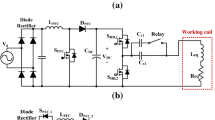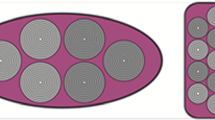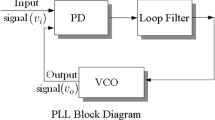Abstract
The single-switch quasi-resonant inverter topology is typically favored for low-cost and low-output-power applications among the resonant inverters used in induction heating systems. Despite the low-cost advantage of the quasi-resonant inverter, the soft-switching range is quite narrow, and it is not stable depending on the electrical parameters of the load that is desired to be heated. In addition, to ensure safe operation in induction cookers, it is important to know the properties of the material from which the pan is made, the diameter of the pan, and the coverage ratio between the pan and the coil. Especially in the single-switch quasi-resonant topology, it is complicated to determine pan size and pan position compared to other topologies. On the other hand, closed-loop power control algorithms are essential for single-switch inverter applications. A big relationship exists between pan detection algorithms and closed-loop power control methods used. This study proposes six alternative methods of determining the pan–coil coverage ratio for the single-switch quasi-resonant topology used in domestic induction heating cooktops. Unlike state-of-the-art methods, the proposed methods do not increase the system’s cost since they use the processor for power control, are not complicated, and provide ease of application. Each method is examined in a simulation environment and experimentally for different coverage rates and compared. As a result of the comparison, the diode conduction time method in single-switch quasi-resonant systems is the most appropriate regarding reliability and applicability.












Similar content being viewed by others
References
Sarnago H, Lucia O, Mediano A, Burdio JM (2014) A class-E direct AC–AC converter with multicycle modulation for induction heating systems. IEEE Trans Ind Electron 61(5):2521–2530
Geetha V, Sivachidambaranathan V (2020) Performance evaluation of half bridge AC–AC resonant converter by using various load in domestic purpose of induction heating application. J Ambient Intell Hum Comput 12:7085–7093
Llorente S, Monterde F, Burdío JM, Acero J (2002) A comparative study of resonant inverter topologies used in induction cookers. In: APEC 17th annual IEEE applied power electronics conference and exposition. Dallas, TX, USA
Tulu M. E, Yildirim D (2013) Induction cooker design with quasi resonant topology using jitter drive method. In: IEEE 12th international conference on environment and electrical engineering, Wroclaw, Poland
Lucia O, Burdio JM, Millan I, Acero J, Puyal D (2009) Load-adaptive control algorithm of half-bridge series resonant inverter for domestic induction heating. IEEE Trans Ind Electron 56(8):3106–3116
Sazak B. S, Cetin S (2009) Reducing the number of measurements in induction cooker design. In: IEEE 9th international conference on electronic measurement & instruments, Beijing, China
Acero J, Alonso R, Barragán LA, Burdío JM (2006) Modeling of planar spiral inductors between two multilayer media for induction heating applications. IEEE Trans Magn 42(11):3719–3729
Carretero C, Acero J, Alonso R, Burdío JM, Monterde F (2007) Temperature influence on equivalent impedance and efficiency of inductor systems for domestic induction heating appliances. in: APEC 07–22th annual IEEE applied power electronics conference and exposition. Anaheim, CA, USA
Ozturk M, Oktay U, Yilmaz N, Yardibi HS, Sinirlioglu S (2020) Comparison of pan detection methods for single switch topology used in domestic induction cooking. In: IEEE/SEST international conference on smart energy systems and technologies, Istanbul, Turkey
Park HP, Jung JH (2018) Load-adaptive modulation of a series-resonant inverter for all-metal induction heating applications. IEEE Trans Ind Electron 65(9):6983–6993
Dominguez A, Otin A, Urriza I, Barragan LA, Navarro D (2014) Load identification of domestic induction heating based on particle swarm optimization. IEEE/COMPEL Santander, Spain
Tanaka T (1989) A new induction cooking range for heating any kind of metal vessels. IEEE Trans Consum Electron 35(3):635–641
Kilic VT, Unal E, Demir HV (2016) Wireless metal detection and surface coverage sensing for all-surface induction heating. Sensors 16(3):363
Lucia O, Navarro D, Guillen P, Sarnago H, Lucia S (2019) Deep learning-based magnetic coupling detection for advanced induction heating appliances. IEEE Access 7:181668–181677
Villa J, Barragan LA, Artigas JI, Navarro D, Dominguez A, Cabeza T (2020) SoC-based in-cycle load identification of induction heating appliances. IEEE Trans Ind Electron 68(8):6762–6772
Acero J, Carretero C, Millán I, Lucía O, Alonso R, Burdío JM (2011) Analysis and modeling of planar concentric windings forming adaptable-diameter burners for induction heating appliances. IEEE Trans Power Electron 26(5):1546–1558
Villa J, Navarro D, Dominguez A, Artigas JI, Barragan LA (2021) Vessel recognition in induction heating appliances-a deep-learning approach. IEEE Access 9:16053–16061
Jimenez O, Lucia O, Barragan LA, Navarro D, Artigas JI, Urriza I (2014) FPGA-based test-bench for resonant inverter load characterization. IEEE Trans Ind Inf 9(3):1645–1654
Sarnago H, Lucia O, Burdio JM (2017) A versatile resonant tank identification methodology for induction heating systems. IEEE Trans Power Electron 33(3):1897–1901
Jimenez O, Lucia O, Urriza I, Barragan LA, Navarro D (2014) Analysis and implementation of FPGA-based online parametric identification algorithms for resonant power converters. IEEE Trans Ind Inf 10(2):1144–1153
Jimenez O, Barragan L. A, Navarro D, Artigas J. I, Urriza I, Lucia O (2011) FPGA-based harmonic computation through 1-bit data stream signals from delta-sigma modulators applied to induction heating appliances. In: IEEE applied power electronics conference and exposition, pp 1776–1781
Sarnago H, Lucia O, Burdio JM (2018) FPGA-based resonant load identification technique for flexible induction heating appliances. IEEE Trans Ind Electron 65(12):9421–9428
Li ZF, Hu JC, Huang MS, Lin YL, Lin CW, Meng YM (2022) Load estimation for induction heating cookers based on series RLC natural resonant current. MDPI Energies 15(4):1294
Bono-Nuez A, Martin-Del-Brio B, Bernal-Ruiz C, Pere-Cebolla FJ, Martinez-Iturbe A, Sanz-Gorrachategui I (2018) The inductor as a smart sensor for material identification in domestic induction cooking. IEEE Sens J 18(6):2462–2470
Ozturk M, Zungor F, Emre B, Oz B (2022) Quasi resonant inverter load recognition method. IEEE Access 10:89376–89386
Jimenez O, Lucia O, Urriza I, Barragan LA, Navarro D (2014) Power measurement for resonant power converters applied to induction heating applications. IEEE Trans Power Electron 29(12):6779–6788
Sarnago H, Lucia O, Navarro D, Burdio JM (2015) Operating conditions monitoring for high power density and cost-effective resonant power converters. IEEE Trans Power Electron 31(1):488–496
Dominguez A, Barragan LA, Otin A, Navarro D, Puyal D (2014) Inverse-based power control in domestic induction-heating applications. IEEE Trans Ind Electron 61(5):2612–2621
Jimenez O, Lucia O, Urriza I, Barragan LA, Navarro D (2014) Design and evaluation of a low-cost high-performance \(\Sigma -\Delta \) ADC for embedded control systems in induction heating appliances. IEEE Trans Ind Electron 61(5):2601–2611
Jimenez O, Lucia O, Urriza I, Barragan A, Mattavelli P, Boroyevich D (2014) An FPGA-based gain-scheduled controller for resonant converters applied to induction cooktops. IEEE Trans Power Electron 29(4):2143–2152
Sheikhian I, Kaminski N, Voß S, Scholz W, Herweg E (2013) Optimisation of quasi-resonant induction cookers. In: IEEE/EPE 15th European conference on power electronics and applications, Lille, France
Oh YS, Yeon JE, Cho KM, Kim HJ (2017) Resonant VLT of single-ended resonant inverter for induction heating. IET Electron Lett 53(12):804–806
Komatsu WPW (1998) A simple and reliable class E inverter for induction heating applications. Int J Electron 84(2):157–165
Author information
Authors and Affiliations
Corresponding author
Additional information
Publisher's Note
Springer Nature remains neutral with regard to jurisdictional claims in published maps and institutional affiliations.
Rights and permissions
Springer Nature or its licensor (e.g. a society or other partner) holds exclusive rights to this article under a publishing agreement with the author(s) or other rightsholder(s); author self-archiving of the accepted manuscript version of this article is solely governed by the terms of such publishing agreement and applicable law.
About this article
Cite this article
Altintas, N., Ozturk, M. & Oktay, U. Performance evaluation of pan position methods in domestic induction cooktops. Electr Eng 105, 2559–2571 (2023). https://doi.org/10.1007/s00202-023-01837-z
Received:
Accepted:
Published:
Issue Date:
DOI: https://doi.org/10.1007/s00202-023-01837-z




